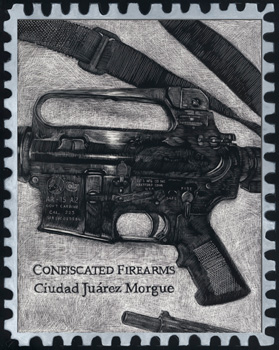
Sgraffito drawings by Texan artist Alice Leora Briggs joined new prints by Guatemalan photographer Luis Gonzalez Palma and historic works by Mexican documentary photographer Rodrigo Moya at Tucson's Etherton Gallery in the exhibition "Ojos Bien Abiertos / Eyes Wide Open." The portraits of Luis Gonzalez Palma are open-eyed indeed. Gelatin silver prints hand-toned in sepia and bitumen, the eyes are made intense by removing the added color to the paper's white. His subjects are women, cast in a light that seems to emanate from the skin, calm of expression, imbued with silence and waiting. Their gaze reflects the viewer's, and is returned like a gift. Originally from Guatemala and trained as an architect, Gonzalez Palma now resides in Argentina with his wife the poet Graciela de Oliveira with whom he collaborates, pairing words with images. The glance is even, no looking up or down, no hierarchies. But there is difference here that is inescapably sexual if not necessarily erotic.
Placed next to these intimate studies, the documentary photography of Rodrigo MoyaÑshot in Mexico and Latin America from 1955 to 1968Ñexudes an heroic, though often bittersweet air. Political and religious processions are seen as distant tableaux, and even a close-up of two women peering from a train window hints at the unseen but felt horizon. Children asleep on a floor under the eyes of a young matron join as revolutionary equals, uniformed guerrilleros under jungle canopy. With the collection are contact sheets of a happy, confident Che Guevara, laughing and smoking a cigar. In the late 1960s Moya left photography for a career in editorial writing; though well known in Mexico, his work is not often seen in this country. Perhaps it is because faith in social progress is now seen as naive, atavistic.
Alice Leora Briggs' works in sgraffito are culled from the book "Dreamland: The Way Out of Juarez," illustrated by Briggs with text by Charles Bowden. The drawings mix macabre photograph-like images of gang-led police executions with graphic quotations from North Renaissance engravings intertwined to recount a story of official corruption and legal indifference in the Mexico/US drug wars. Following reports of an undercover ICE (US Immigration and Customs Enforcement) operation gone wrong in Juarez, Mexico, "Dreamland" depicts a place where names and borders have become unreal and politics is a flimsy cover story for an economy of murder. Matched with Gonzalez Palma's entirely personal portraits, Brigg's drawings bookend the show, surrounding Moya's documents of optimism with two alternatives to history: love or death.
This article was written for and published in art ltd. magazine ![]()
